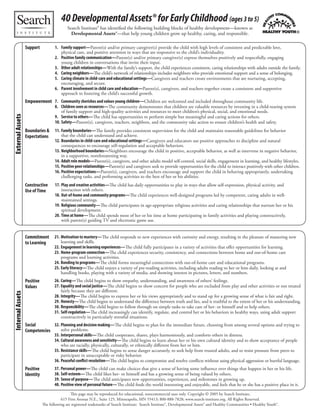Más contenido relacionado
La actualidad más candente (20)
Similar a 40 assetsec (20)
40 assetsec
- 1. 40DevelopmentalAssets®forEarlyChildhood (ages3to5)
Search Institute® has identified the following building blocks of healthy development—known as
Developmental Assets®—that help young children grow up healthy, caring, and responsible.
1. Family support—Parent(s) and/or primary caregiver(s) provide the child with high levels of consistent and predictable love,
physical care, and positive attention in ways that are responsive to the child’s individuality.
2. Positive family communication—Parent(s) and/or primary caregiver(s) express themselves positively and respectfully, engaging
young children in conversations that invite their input.
3. Other adult relationships—With the family’s support, the child experiences consistent, caring relationships with adults outside the family.
4. Caring neighbors—The child’s network of relationships includes neighbors who provide emotional support and a sense of belonging.
5. Caring climate in child-care and educational settings—Caregivers and teachers create environments that are nurturing, accepting,
encouraging, and secure.
6. Parent involvement in child care and education—Parent(s), caregivers, and teachers together create a consistent and supportive
approach to fostering the child’s successful growth.
7. Community cherishes and values young children—Children are welcomed and included throughout community life.
8. Children seen as resources—The community demonstrates that children are valuable resources by investing in a child-rearing system
of family support and high-quality activities and resources to meet children’s physical, social, and emotional needs.
9. Service to others—The child has opportunities to perform simple but meaningful and caring actions for others.
10. Safety—Parent(s), caregivers, teachers, neighbors, and the community take action to ensure children’s health and safety.
11. Family boundaries—The family provides consistent supervision for the child and maintains reasonable guidelines for behavior
that the child can understand and achieve.
12. Boundaries in child-care and educational settings—Caregivers and educators use positive approaches to discipline and natural
consequences to encourage self-regulation and acceptable behaviors.
13. Neighborhood boundaries—Neighbors encourage the child in positive, acceptable behavior, as well as intervene in negative behavior,
in a supportive, nonthreatening way.
14. Adult role models—Parent(s), caregivers, and other adults model self-control, social skills, engagement in learning, and healthy lifestyles.
15. Positive peer relationships—Parent(s) and caregivers seek to provide opportunities for the child to interact positively with other children.
16. Positive expectations—Parent(s), caregivers, and teachers encourage and support the child in behaving appropriately, undertaking
challenging tasks, and performing activities to the best of her or his abilities.
17. Play and creative activities—The child has daily opportunities to play in ways that allow self-expression, physical activity, and
interaction with others.
18. Out-of-home and community programs—The child experiences well-designed programs led by competent, caring adults in well-
maintained settings.
19. Religious community—The child participates in age-appropriate religious activities and caring relationships that nurture her or his
spiritual development.
20. Time at home—The child spends most of her or his time at home participating in family activities and playing constructively,
with parent(s) guiding TV and electronic game use.
Support
Empowerment
Boundaries &
Expectations
Constructive
Use ofTime
ExternalAssets
This page may be reproduced for educational, noncommercial uses only. Copyright © 2005 by Search Institute,
615 First Avenue N.E., Suite 125, Minneapolis, MN 55413; 800-888-7828; www.search-institute.org. All Rights Reserved.
The following are registered trademarks of Search Institute: Search Institute®, Developmental Assets® and Healthy Communities • Healthy Youth®.
InternalAssets
21. Motivation to mastery—The child responds to new experiences with curiosity and energy, resulting in the pleasure of mastering new
learning and skills.
22. Engagement in learning experiences—The child fully participates in a variety of activities that offer opportunities for learning.
23. Home-program connection—The child experiences security, consistency, and connections between home and out-of-home care
programs and learning activities.
24. Bonding to programs—The child forms meaningful connections with out-of-home care and educational programs.
25. Early literacy—The child enjoys a variety of pre-reading activities, including adults reading to her or him daily, looking at and
handling books, playing with a variety of media, and showing interest in pictures, letters, and numbers.
26. Caring—The child begins to show empathy, understanding, and awareness of others’ feelings.
27. Equality and social justice—The child begins to show concern for people who are excluded from play and other activities or not treated
fairly because they are different.
28. Integrity—The child begins to express her or his views appropriately and to stand up for a growing sense of what is fair and right.
29. Honesty—The child begins to understand the difference between truth and lies, and is truthful to the extent of her or his understanding.
30. Responsibility—The child begins to follow through on simple tasks to take care of her- or himself and to help others.
31. Self-regulation—The child increasingly can identify, regulate, and control her or his behaviors in healthy ways, using adult support
constructively in particularly stressful situations.
32. Planning and decision making—The child begins to plan for the immediate future, choosing from among several options and trying to
solve problems.
33. Interpersonal skills—The child cooperates, shares, plays harmoniously, and comforts others in distress.
34. Cultural awareness and sensitivity—The child begins to learn about her or his own cultural identity and to show acceptance of people
who are racially, physically, culturally, or ethnically different from her or him.
35. Resistance skills—The child begins to sense danger accurately, to seek help from trusted adults, and to resist pressure from peers to
participate in unacceptable or risky behavior.
36. Peaceful conflict resolution—The child begins to compromise and resolve conflicts without using physical aggression or hurtful language.
37. Personal power—The child can make choices that give a sense of having some influence over things that happen in her or his life.
38. Self-esteem—The child likes her- or himself and has a growing sense of being valued by others.
39. Sense of purpose—The child anticipates new opportunities, experiences, and milestones in growing up.
40. Positive view of personal future—The child finds the world interesting and enjoyable, and feels that he or she has a positive place in it.
Commitment
to Learning
Positive
Values
Social
Competencies
Positive
Identity

